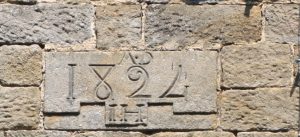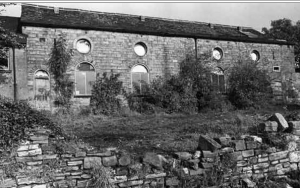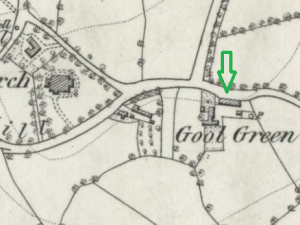Origins
Where Fulwood Road broadens out before it ends at the junction with Canterbury Avenue is a large rectangular building with a forbidding façade. This substantial building had begun life in 1824 as a barn for Goole Green Farm so entrances and windows faced away from the road.

Date stone on south wall
On the track at the east of the Guildhall there are some kerbstones and it is possible to detect a curving path into the yard at the front of the building.

The Guildhall from the south (1950s)
None of the lower windows were part of the original building and it is likely that the round apertures were originally unglazed. There are ventilation slits in the upper parts of the wall. The original entrance is to the left of the down pipe.
The barn was part of Goole Green Farm which had been in existence when the barn was built. Neville Flavell in his book “From Goole Green to Nether Green” (2005) says that “in 1756, Sarah Woodhouse a farmer’s wife heard a Methodist preacher at Ranmoor and issued an open invitation to him to make Goole Green Farm the home of an emergent Society. The farm which was also an alehouse remained the Society’s home for nearly 30 years.
Flavell tells us that Sarah Moore, a young woman who was living in Fargate at the time, was tasked with establishing the Society. Moore and John Wesley corresponded and in 1791 he wrote of his intention to visit Sheffield, staying with the Moores, and that ‘probably I may see Hallam too’ but there is no record of his visiting Hallam.

Location
When the 1851 census was taken, Thomas Andrew(s), a widower aged 60, was recorded as being a farmer of 11 acres at Gold Green (the name was spelt in many ways over the years) whilst most of his neighbours were cutlers. Thomas was still farming at Gool Green ten years later, sharing his house with 22 year old Horatio Lyden. Lyden was a monumental engraver probably working for the Hancocks, a family who for many generations were the local sextons and suppliers of gravestones, as well as builders. Thomas Andrew died in March 1871 a month before the census was taken so we don’t know when he stopped farming but we do know from the census that the farm was in the hands of Cornelius Hudson and his family.
Cornelius probably wasn’t cut out for farming as by 1881 he had been replaced by William Watson, a ‘Cowkeeper, grazing 12 Acres emp a boy’ as recorded in the census. Watson was in turn replaced by Charles Spittlehouse 10 years later. Spittlehouse was the last person to be described as farmer on a census as in 1901 Joseph Westby and his extended family were living there. Westby, a cutlery manufacturer, had moved to the farm in 1905 and remained there until his death in 1929, his wife, Charlotte, continued living there until her death in 1936.
